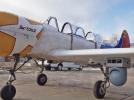Ryanair B738 near Perugia on Jul 18th 2013, severe turbulence injures flight attendant
A Ryanair Boeing 737-800, registration EI-DWF performing flight FR-7198 from Rome Ciampino (Italy) to Leipzig (Germany) with 129 passengers and 6 crew, was climbing from FL230 to FL340 out of Rome in the area of Perugia (Italy) when the aircraft encountered expected severe turbulence causing injuries to a flight attendant in the aft galley of the aircraft. The flight attendant, although in pain and unable to walk, insisted the flight be continued to destination, where the aircraft landed safely. The flight attendant sustained serious injuries.
The flight attendantly subsequently requested to return to Rome for treatment and was accomodated on board of the aircraft for the return to Rome, which was performed with 3 cabin crew on duty and less than 150 passengers.
The Irish AAIU released their final report stating, that Italy's ANSV delegated the investigation to the AAIU. The AAIU concluded the probable causes of the acident were:
Unrestrained movement of the No. 2 CCM during sudden and unexpected severe turbulence.
Contributory Factors
Cb activity and turbulence was not forecast over peninsular Italy in the prognostic weather charts included in the Flight Crew’s briefing pack.
The AAIU reported that the flight attendant received a fractured pelvis as result of the turbulence encounter, that had lifted her off the ground, she hit the cabin ceiling with her head and was thrown back onto the ground.
The first officer (28, CPL, 1,050 hours total, 840 hours on type) was pilot flying, the captain (39, ATPL, 3,880 hours total, 3,650 hours on type) was pilot monitoring.
The flight brief received by the crew did not indicate any turbulence on their way onto Leipzig, the provided weather data and charts had the captain conclude the weather "was pretty good".
While climbing out of Rome the crew became aware of a CB clouds and requested to deviate around those clouds, once clear they received instruction to proceed direct to their next waypoint. The commander, in view of the CBs, decided to not extinguish the fasten seat belt signs as a precaution.
After being clear of the CBs and on direct route to the next waypoint the aircraft entered instrument meteorological conditions and encountered light turbulence followed by severe turbulence. The aircraft climbed out of instrument meteorological conditions shortly after, in visual meteorological conditions the turbulence ceased. The crew commented the turbulence encounter took no longer than 5, maybe 10 seconds, the closest CB was at least 10nm away, there had been no returns on the weather radar.
Following the turbulence event the commander talked to the purser and was informed that the flight attendant in the rear galley had been lifted of her feet and was in pain unable to walk or continue duties, but was adament to continue to destination despite the captain's offer to return to Rome. She was relieved from duty and was accomodated in seats near the aft galley.
After arrival in Leipzig the flight attendant was looked after by an emergency doctor, she wanted to return to Rome for medical treatment, the doctor said she was fit to fly to Rome and was able lay down across three seats. After return to Rome the hospital diagnosed a fractured pelvis.
The AAIU reported the injured flight attendant gave testimony that when light turbulence occurred she got seated but did not have time to fasten her harness when the severe turbulence occurred. After landing in Leipzig she asked the commander to not offload her in Leipzig because she didn't want to be alone in Germany.
The AAIU reported that the flight data recorder recorded vertical accelerations of -0.46G followed by +1.52G during the turbulence encounter.
The AAIU anaysed that the crew did not advise ATC about the turbulence encounter due to being busy to establish the nature of the flight attendant's injury, although the standard operating procedures required a notification to ATC in order to prevent further injuries by preventing other aircraft entering the zone of turbulence.
The AAIU analysed: "The weather prognostic charts received by the Flight Crew as part of their flight briefing pack did not indicate the presence of Cb activity over the Italian peninsula. Additionally, the SIGMETs valid at the time of the occurrence did not highlight Cbs or thunderstorms in the Apennine area, which includes the area where the turbulence was encountered. However, such activity was referred to in the AIRMET issued at 12.50 hrs for the Rome FIR.
The Flight Crew were aware of Cb activity on their flight path and, like other aircraft in the area, they requested and received ATC clearance to bypass this. Nevertheless, this event highlights the importance of accurate weather forecasting and its role in flight planning and associated pre-flight briefings."
Accelerations according to flight data recorder (Graphics: AAIU):
http://avherald.com/h?article=4783aee2














Komentarze